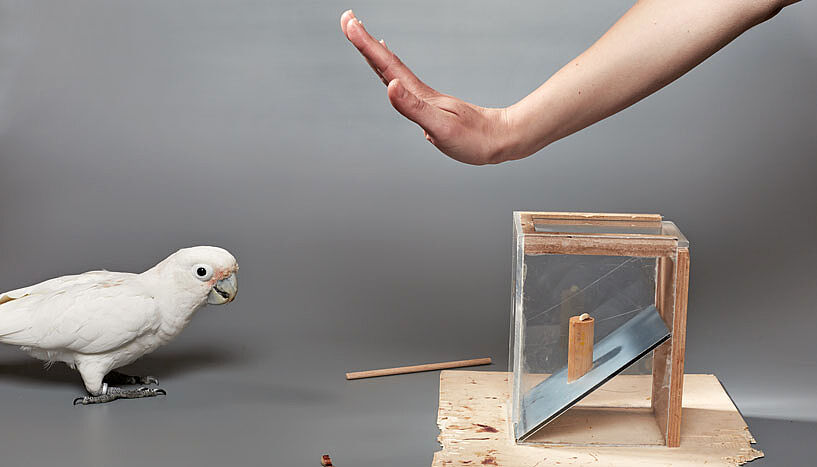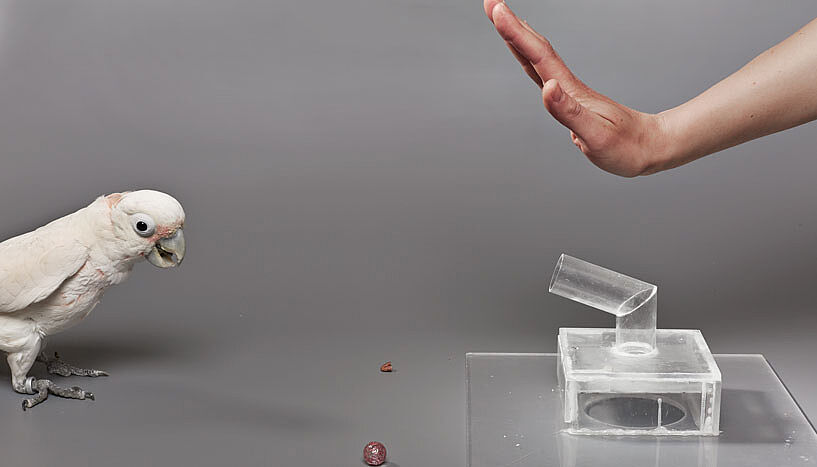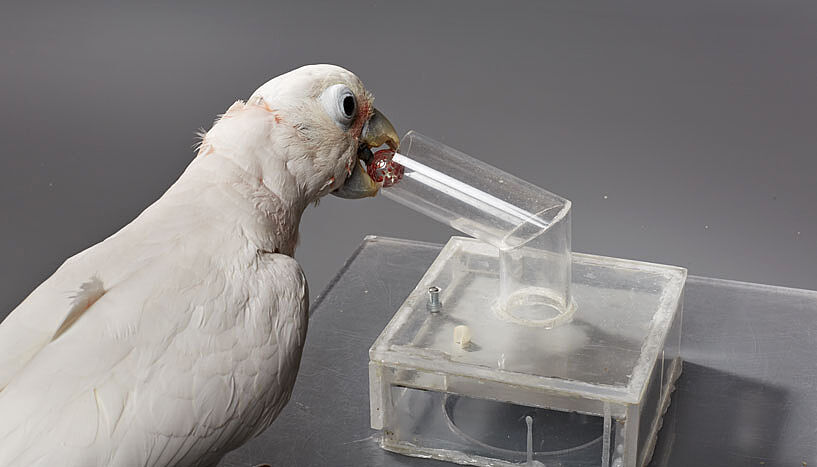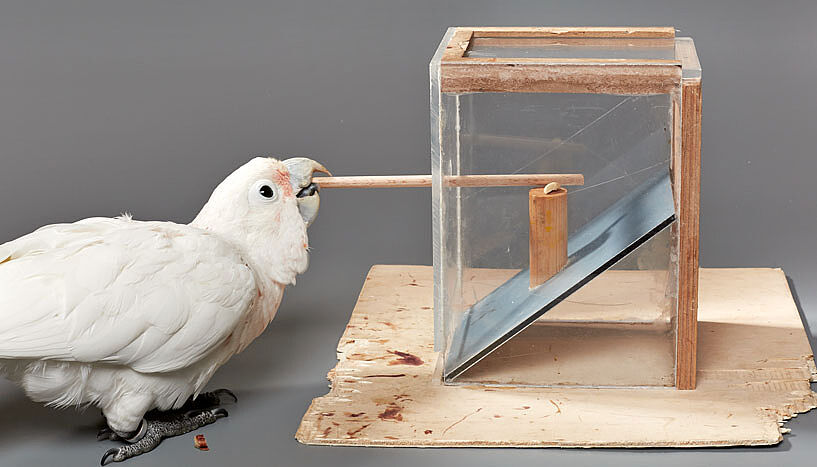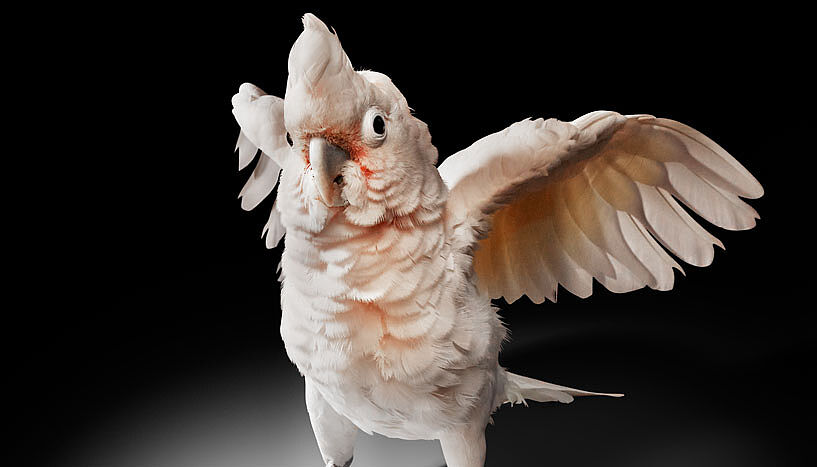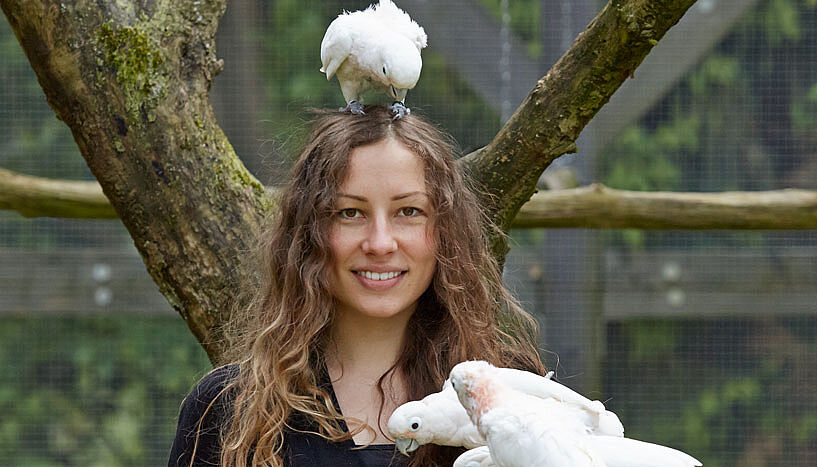To tool or not to tool?
23. Juni 2016Clever cockatoos make economic decisions about tool use depending on the current "market" situation
Flexible tool use is closely associated to intelligent mental processes such as the ability to plan actions. Cognitive biologists from the University of Vienna and the University of Veterinary Medicine in Vienna studied tool related decision making in an Indonesian cockatoo. They found that the animals seemed to carefully ponder about their choices: eat an immediately available food reward or wait and use a tool to obtain another reward instead? While doing so the animals scrutinized details such as differences in quality between the two food rewards, but also the functionality of the available tool as means to obtain the out-of reach food in the situation at hand.
As animal tool use events are extremely rare, is often quickly rated as intelligent. Nevertheless, some types of tool use can be controlled by much simpler processes that are a part of the respective animal’s inborn behavioural repertoire. Intelligent tool use requires the ability to flexibly adapt a behaviour to changing environmental situations. The Indonesian Goffin's cockatoo has even the rare capacity to use two different types of tools (sticks for probing and raking food into reach as well dropping stones/balls into tubes to knock out a reward inside). The same birds also previously showed a solid performance in the classic "marshmallow" experiment from human psychology: They controlled their impulse to consume an immediate lower quality food item in the prospect of gaining a better food type after a time delay.
Isabelle Laumer, Alice Auersperg und Thomas Bugnyar from the University of Vienna and the Veterinary University of Vienna now investigate flexibility in tool related decision-making in the Goffin's cockatoo. Two different types of food items were used: Cashew nut which is their favourite food type and Pecan nut which the birds like but disregard if cashew nut is available as well. The also used two types of apparatuses containing a food item which was temporarily out-of-reach and two types of tools: an apparatus which is only operable by probing with a stick tool but not by dropping a ball inside and an apparatus which could only be operated by dropping a ball inside but not by probing with a stick. During testing, an apparatus was placed on a table and a choice between two items (usually a food item and a tool) was offered alongside. Once birds had picked one item the other was immediately removed. Interestingly, the cockatoos flexibly adapted their decisions to different situations. "If a lower value food or a high value food was out-of-reach inside the apparatus and the choice was between a high value food item and a tool, they chose the food over the tool, even when the tool was functional for the apparatus", explains Isabelle Laumer who conducted the study as part of her PhD thesis. "However, when the cockatoos could decide between the lower value food and a tool they choose the tool but only provided that it worked for the available apparatus: For example when the stick and the lower value food was available but the ball apparatus was on the table they chose the low value food over the tool. When the stick apparatus with the high value food inside was available they chose the stick tool over the immediate lower value food", she further elaborates. Nevertheless, the birds’ ability to solve the problem stopped when both apparatuses were offered at the same time each bearing a different food type and the decision was between the both tools. In the latter case researchers believe that the animals may have hit a limit in working memory capacity due to the amount of task components involved.
"Our findings parallel previous results in primates: the cockatoos could overcome immediate impulses in favor of future gains even if this implied tool use. Beyond that we additionally found that they at same time attended to the functionality of the available tool in the present contex", says Alice Auersperg, Head of the Goffin Lab in Austria. She continues: "As wild Goffin cockatoos are unlikely to be specialized on tool use, this shows that tool related decision-making can arise from relatively general modes of cognitive processing as, for example a combination of flexibility, sensorimotor and impulse control."
Publication in "Scientific Reports":
Flexible decision-making relative to reward quality and tool functionality in Goffin cockatoos (Cacatua goffiniana): Isabelle Laumer, Thomas Bugnyar, Alice Auersperg. In Scientific Reports
DOI: 10.1038/srep28380
More information on the Goffin Lab:
https://www.vetmeduni.ac.at/en/messerli/science/cognition/wildlife/goffin-lab/
Wissenschaftlicher Kontakt
Dr. Isabelle Laumer
Department für KognitionsbiologieUniversität Wien
, 1090 - Wien, Althanstraße 14 (UZA I)
+43-680-124 66 28
isabelle.laumer@univie.ac.at
Dr. Alice Auersperg
Head of Goffin Lab – Messerli ForschungsinstitutVeterinärmedizinische Universität Wien
, 1210 - Wien, Veterinärplatz 1
+43-676-939 03 92
alice.auersperg@vetmeduni.ac.at
Rückfragehinweis
Mag. Alexandra Frey
Media Relations ManagerUniversität Wien
1010 - Wien, Universitätsring 1
+43-1-4277-17533
+43-664-8175675
alexandra.frey@univie.ac.at
Downloads:
Goffini-Kakadus_6.2016___61_.tif
Dateigröße: 29,82 MB
Goffini-Kakadus_6.2016___58_.tif
Dateigröße: 27,76 MB
Goffini-Kakadus_6.2016___59_.tif
Dateigröße: 28,42 MB
Goffini-Kakadus_6.2016___64_.tif
Dateigröße: 18,89 MB
Goffini-Kakadus_6.2016___56_.tif
Dateigröße: 8,28 MB
Goffini-Kakadus_6.2016___66_.tif
Dateigröße: 59,32 MB

